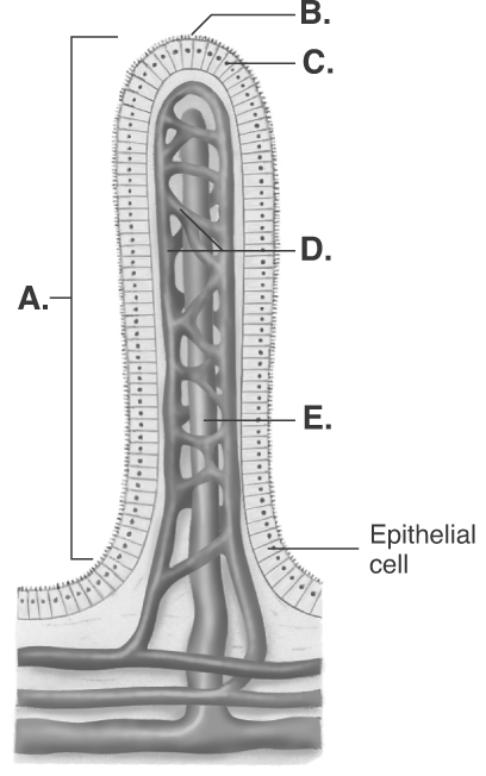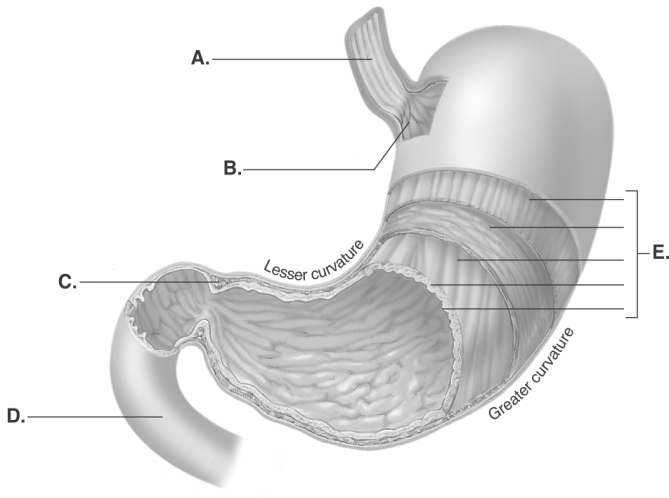A) Secretions from the liver and pancreas enter this organ.
B) Segmentation contractions occur in this organ.
C) Both digestion and absorption occur in this organ.
D) Mixing and propulsion of chyme.
E) All of these choices apply to the small intestine.
Correct Answer

verified
Correct Answer
verified
Multiple Choice
 -The diagram illustrates an absorptive structure in the duodenum. What does "D" represent?
-The diagram illustrates an absorptive structure in the duodenum. What does "D" represent?
A) microvilli
B) epithelial cell
C) capillary
D) lacteal
E) villus
Correct Answer

verified
Correct Answer
verified
Multiple Choice
Which of the following components of saliva is mismatched with its function?
A) mucin - lubricant
B) lysozyme - antibacterial properties
C) bicarbonate - neutralizes acid
D) IgA - prevents infection
E) salivary amylase - begins protein digestion
Correct Answer

verified
Correct Answer
verified
Multiple Choice
Match the mesenteries or membranes with its appropriate description. -transverse mesocolon
A) mesentery of the small intestine
B) serous membrane that covers organs
C) attaches the liver to the diaphragm
D) connects lesser curvature of stomach to the liver
E) mesentery of the colon
Correct Answer

verified
Correct Answer
verified
Multiple Choice
The major secretion of the large intestine is
A) bile.
B) hormones.
C) mucus.
D) vitamins.
E) bacteria.
Correct Answer

verified
Correct Answer
verified
Multiple Choice
Which of the following is NOT an accessory organ of the digestive tract?
A) esophagus
B) salivary glands
C) pancreas
D) gallbladder
Correct Answer

verified
Correct Answer
verified
Multiple Choice
Match the disorder with the best description. -GERD
A) inflammation of the liver
B) watery feces
C) bad breath
D) enlargement or inflammation of the vein of the anal canal
E) chronic acid in the esophagus
Correct Answer

verified
Correct Answer
verified
Multiple Choice
Arrange the following events in the correct order: (1) absorption of lipids (2) emulsification (3) micelle formation (4) digestion of lipids
A) 1, 2, 3, 4
B) 3, 4, 2, 1
C) 4, 1, 2, 3
D) 2, 4, 1, 3
E) 2, 4, 3, 1
Correct Answer

verified
Correct Answer
verified
Multiple Choice
Match the enzyme or hormone with the organ that produces it. -salivary amylase
A) salivary glands
B) stomach
C) liver
D) small intestine
E) pancreas
Correct Answer

verified
Correct Answer
verified
Multiple Choice
The esophagus
A) extends from the fauces to the stomach.
B) has cartilage in its walls to keep it from collapsing.
C) produces two enzymes that digest proteins.
D) has upper and lower sphincters to regulate movement of food.
E) has thin walls of connective tissue.
Correct Answer

verified
Correct Answer
verified
Multiple Choice
Which of the following cell types is correctly matched with its function?
A) endocrine cells - produce mucus
B) absorptive cells - produce digestive enzymes
C) granular cells - absorb nutrients
D) goblet cells - produce hormones
E) granular cells - produce granules
Correct Answer

verified
Correct Answer
verified
Multiple Choice
 -The diagram illustrates the anatomy of the stomach. What does "C" represent?
-The diagram illustrates the anatomy of the stomach. What does "C" represent?
A) muscularis
B) duodenum
C) esophagus
D) pyloric sphincter
E) cardiac part
Correct Answer

verified
Correct Answer
verified
Multiple Choice
Secretions that are added as food moves through the GI tract assist in
A) liquefying and digesting the food.
B) vitamin A and D production and storage.
C) distribution of nutrients throughout the body.
D) insulin production.
E) bile production.
Correct Answer

verified
Correct Answer
verified
Multiple Choice
LDL's are taken into a cell by the process of
A) simple diffusion.
B) osmosis.
C) receptor mediated endocytosis.
D) HDL carrier molecules.
E) facilitated diffusion.
Correct Answer

verified
Correct Answer
verified
Multiple Choice
The ____ helps hold a tooth in its socket.
A) crown
B) cementum
C) periodontal ligament
D) dental arch
E) alveoli
Correct Answer

verified
Correct Answer
verified
Multiple Choice
 -The diagram illustrates an absorptive structure in the duodenum. What does "B" represent?
-The diagram illustrates an absorptive structure in the duodenum. What does "B" represent?
A) microvilli
B) epithelial cell
C) capillary
D) lacteal
E) villus
Correct Answer

verified
Correct Answer
verified
Multiple Choice
Functions of the liver include
A) production of many blood proteins.
B) interconversion of nutrients.
C) detoxification of harmful chemicals.
D) bile production.
E) All of these are functions of the liver.
Correct Answer

verified
Correct Answer
verified
Multiple Choice
Which of the following regions of the stomach is correctly matched with its description?
A) body - portion closest to the esophagus
B) pylorus - the most inferior portion of the stomach
C) fundus - opening from the stomach into the duodenum
D) cardiac region - the largest portion of the stomach
E) pyloric opening - opening from the esophagus
Correct Answer

verified
Correct Answer
verified
Multiple Choice
The defecation reflex
A) is stimulated by distention of the rectum.
B) inhibits further peristalsis in the rectum and lower colon.
C) constricts the internal anal sphincter.
D) lasts several hours.
E) None of these choices is correct.
Correct Answer

verified
Correct Answer
verified
Multiple Choice
The abdominal cavity is lined with
A) the omental bursa.
B) mesenteries.
C) the greater omentum.
D) parietal peritoneum.
E) superficial fascia.
Correct Answer

verified
Correct Answer
verified
Showing 41 - 60 of 258
Related Exams